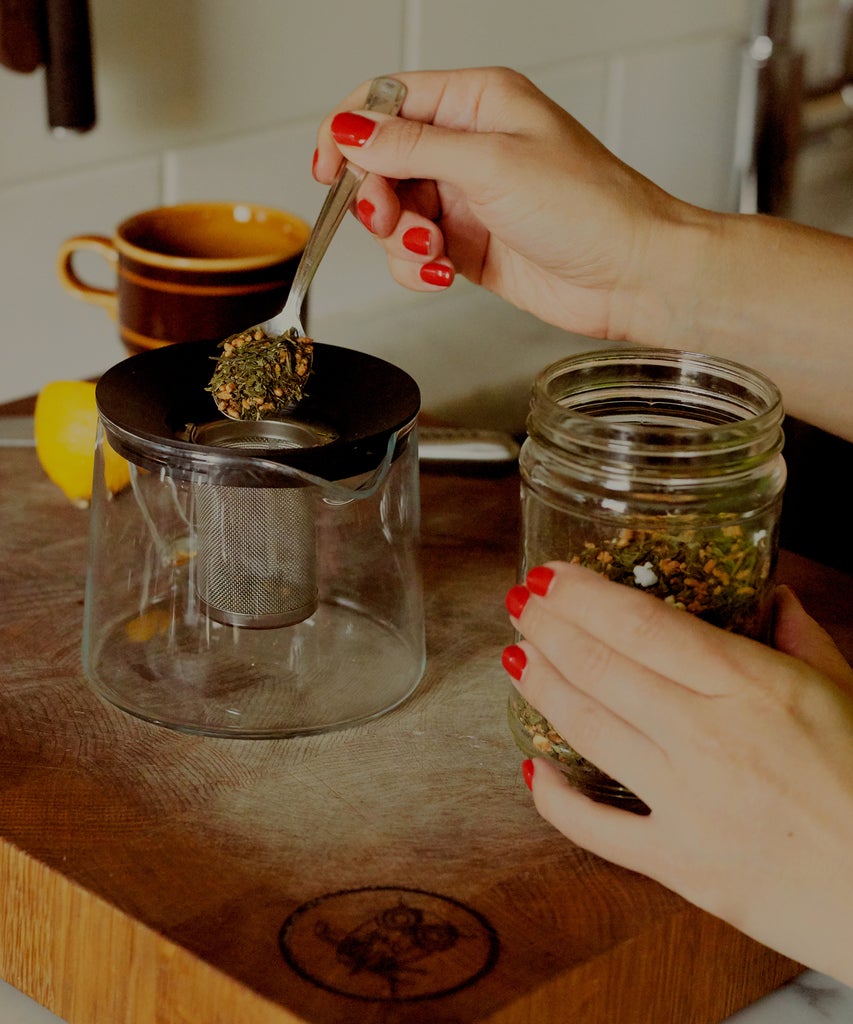
The first time I was introduced to tea leaf readings was through Harry Potter and The Prisoner of Azkaban at the ripe age of 8. And I’ll be honest — Professor Trelawney’s reaction to finding out that Harry had “the grim” in his teacup (an omen of death) was a pretty scary scene for me at the time. But reading tea leaves isn’t just a spooky part of your favorite fantasy franchise — it’s a real practice, and a divination tool that’s not just used by fictional wizards at Hogwarts School of Witchcraft and Wizardry.
Sandra Mariah Wright and Leanne Marrama, two Salem-based witches and authors of Reading the Leaves: An Intuitive Guide to the Ancient Art and Modern Magic of Tea Leaf Divination, believe that anyone who wants to can use this divination tool — in fact, it’s perfect for beginners.
“It’s a great way to get started with divination because nobody really expects anybody to memorize what every symbol means,” Wright tells R29. “It’s very open to interpretation.”
“I feel that tea leaf readings are for anyone,” Marrama tells R29. “It is a great tool to empower people and help people take control of the future that beholds them.”
Marrama points out that tea leaf readings — also called tasseography — can help people make peace with their past. More specifically, she says that “it opens up the soul.” So if you’re ready to dive in to the world of divination, reading your own tea leaves is a great place to start. Here, both Wright and Marrama give us a run-down of everything you’ll need to know.
The equipment
First thing’s first — the cup. “You’ve got to choose a tea cup, it can’t be a straight up-and-down coffee mug,” Wright explains. “You want those sides to flare out at an angle because you want the leaves to be able to cling to the them.” You should also make sure that your tea cup comes with a saucer of some kind — you’ll see why when we get more into the process.
There’s also no need for a specially designed mug, either — you can choose a plain tea cup that you already own, or purchase one that jumps out to you. Just make sure it’s a lighter color, so the leaves are easier to see.
Now for the tea. The best kind to use for a successful reading is loose leaf tea with a broad leaf, and in particular Wright says that oolong or gun powder teas are the best options. Both Wright and Marrama recommend this gunpowder tea that you can purchase from Amazon.
“[These teas] with the long leaves are the ones that make great designs,” Wright says. “You don’t really want to use a tea-bag tea. The kind of tea that’s in tea bags has been processed into tiny little pieces and it won’t make the shapes the way a nice oolong or gunpowder loose tea will.”
It’s all about the atmosphere
Once you’ve got your tea leaf reading gear all settled, it’s time to mentally prepare for your reading. Do some deep breathing or a meditation beforehand to get in the right, chilled-out mindset. Wright and Marrama recommend something called “grounding” — their book describes it as feeling “fully present in your body, and connected to the strong, stable energy of the Earth.” It’s all about being calm and at peace, whatever that means for you.
Think about what you’ll be feeling, hearing, and smelling during this experience. Do you want music? Maybe you want to light a candle or some kind of incense. Set the tone for how your session will go through your senses and set some intentions for your reading.
“Let yourself open up while you’re sitting there. Let it come naturally,” Marrama says. “Meditation, a peaceful atmosphere, those are the things that really make that ability grow.” Both of the Salem-based witches emphasize not feeling nervous during your first time reading the leaves. “You don’t have to be perfect in this,” Marrama says. “People make mistakes.”
Setting up your atmosphere to be calm after your reading is also an important thing to remember. “Realize that some things may come up that are emotional or leave you with a lot to think about, so you want to have a space to do that,” Wright says. “Giving some thought for after the reading is very important to think about.”
Drinking the tea
You’ll want to put about half of a teaspoon of your loose leaf tea in the tea cup. Once your water is boiling, you’ll pour it to fill the cup around 3/4 of the way. Don’t add any milk, cream, honey, or sugar — nothing. And let it steep for three minutes before drinking.
During those few minutes, think of the questions you want answered or what things in your life you need guidance on right now. Then, you’ll begin to drink the tea until only a teaspoon or two of water remains.
Flipping your cup
Once you’ve reached the end of your tea, you’ll want to swirl the cup in the air in front of you three times. According to Wright and Marrama’s book, “Three is a magic number, and this sets the leaves in motion. It’s another way for you to add your energy to the reading.”
After you’ve swirled your tea, you’ll place the saucer upside down on top of your cup and flip it over, allowing the remaining water to drain into the saucer. Wait another minute or two, focusing once again on your questions and intentions for the reading.
When you pick up your tea cup, make sure that the handle is closest to your body once it’s flipped right side up. Then, you’ll be able to look at the leaves that are leftover both inside your cup and on your saucer.
Interpreting your leaves
Now for the fun part — but don’t worry, you don’t have to be a professional tea leaf reader to interpret what’s in your cup. As you look into your leaves, see what shapes and symbols jump out to you first. For example, a clump of tea leaves may look like a heart to you, or a specific letter, or a number, or even an animal. Take a few moments to study what’s inside — more images may become clearer as you continue to look.
As you gather these symbols, see how they fit into your life and how they relate to you personally.
“The personal imagery is first, what connects to you and what it means to you,” Marrama explains. “A horseshoe could mean luck to someone, but different to somebody who recently lost their beloved horse. A rose could mean love, but it could mean a message from somebody who’s crossed over. You should apply what you feel within your own soul and heart first.”
Wright agrees. “We love people to realize that what they connect with when they first look in the cup is oftentimes the most powerful messages,” she says. “They’re the messages where the symbol means something to you personally even if, in the history of tea leaf reading, that symbol may have other meanings. It will have a layer of meaning for you that goes beyond just what is already there.”
In Reading the Leaves, Wright and Marrama have provided an enormous glossary you can refer back to if you want to check in on the traditional meaning of the symbols you’re seeing. For example, if you see a boat, Wright and Marrama’s book says it means, “a meaningful friend or lover will arrive in your life.” If you see a bird, that could mean good luck is on its way. We won’t go into every symbol here, but there are tons of meanings for the little things you’ll notice during your reading.
If you end up pulling a Harry Potter and find a frightening omen in your cup, don’t panic. “Remember that you have the power to change the future,” Wright and Marrama write in Reading the Leaves. “Your reaction to the information you receive, your decisions, and your actions all have an impact of how things turn out.”
The most important thing to remember, both witches say, is to have fun with it. “Try not to take it so deeply serious,” Wright says. “It’s a beautiful, light way to start getting involved with building your own intuitive skills. Being able to trust yourself and trust your gut is much more important than being right.”
from refinery29
A Beginner’s Guide To Reading Tea Leaves
![A Beginner’s Guide To Reading Tea Leaves]() Reviewed by streakoggi
on
August 10, 2020
Rating:
Reviewed by streakoggi
on
August 10, 2020
Rating:




